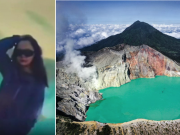
A ghastly slimy looking creature which bears a striking resemblance of the human brain was spotted in a small water body known as "sea lagoon" in the Stanley park in Vancouver, Canada for the first time. What shocked the scientist more is that the creature is multiplying in number but they are unable to find out the reason for the growth.
The terrifying looking organism is an amalgamation of small hundred tiny creatures living inside the body of the blob.
'It's kind of like three-day-old Jell-O, a bit firm but gelatinous", explains Kathleen Stormont, from the Stanley Park Ecology Society, to the Vancouver Courier.
The creatures, known as bryozoans have been inhabiting since hundreds of millions of years, even way before the first dinosaurs walked the Earth.
The species known as magnificent bryozoan or Pectinatella magnifica, found in the Stanley Park are generally found in warmer climates - particularly along the Mississippi river.
The weird ways of bryozoans
The life form is made up of individual asexual organisms called Zooids. The species can multiply without needing to have sex. The remarkable discovery was done by Celina Starnes, a researcher of the Stanley Park Ecology Society. Scientist assumes that climate change might have been the cause of its migration and also substantial growth in population.
"I think we're near the northern limit of them. With warming climate, they might migrate somewhere farther north," said Ian Walker, a biology professor at the University of British Columbia told the National Geographic. He also adds, "I can only really speculate how they might have spread."
The question arises that if they existed for so long, why did we take so much time to find one? This is, scientists argue, for its exceptional camouflaging capabilities. The horrible looking creature blends itself into the environment so well that it becomes extremely difficult to spot them and sometimes we might just mistake them as salamander eggs or rocks.
Although the creature has found to be having spread and migrated towards the west, the growth of the creature is extremely slow and the one, spotted in "sea lagoon" is moreover not alive.
Check out the video here:









